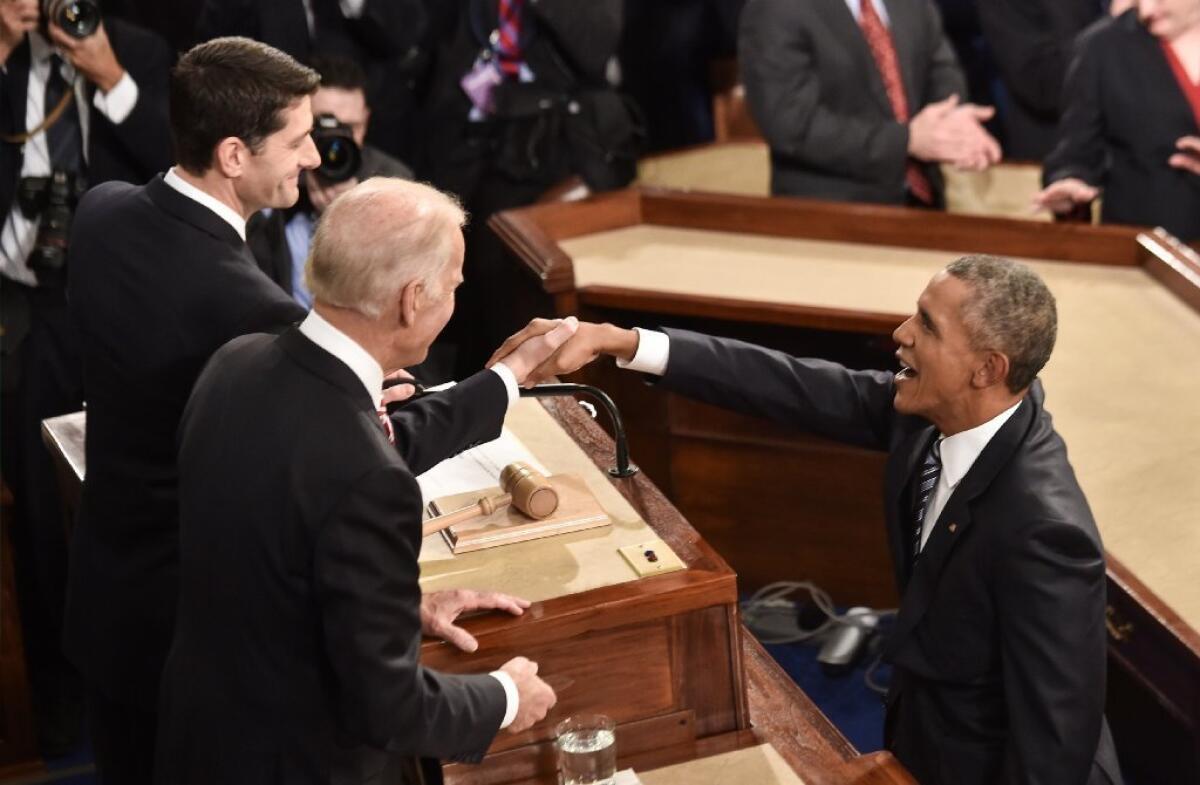A ‘moonshot’ to cure cancer: Realistic hope or a search for green cheese?

In his State of the Union address Tuesday, President Obama called for a “moonshot” to cure cancer, and put Vice President Joe Biden in charge of the effort. Cancer researchers cheered.
In his final State of the Union address Tuesday night, President Obama was widely said to have conceded to his lame-duck status and an atmosphere of paralyzing political partisanship by avoiding ambitious initiatives.
Then again, there was that cancer “moonshot” thing.
“For the loved ones we’ve all lost, for the families that we can still save, let’s make America the country that cures cancer once and for all,” Obama said. Referring to Congress’ recent approval of a $2-billion increase in 2016 funds for the National Institutes of Health, he added that “medical research is critical.”
And with that, he put Vice President Joe Biden in charge of the effort, and moved on to chide those holding out on climate change.
Though many Americans were asking one another, “What did he just say?” scientists and physicians in search of cancer cures were cheering. Many of them have long sought to tamp down bravura talk of a “cure.” But on Wednesday, quite a few were happy to embrace it.
Dr. Otis Brawley, chief medical officer for the American Cancer Society, declined to use the word “cure” in commenting on Obama’s and Biden’s “moonshot” initiative. But he called Obama’s words “a galvanizing call for a renewed effort to find new tools to fight cancer.”
Other scientists were not put off by either the brevity of Obama’s launch or the apparent ambition of his reach: Cancer -- or cancers, as they refer to the broad range of diseases that go by the name -- are already on the ropes, they said. With a concerted effort to push existing scientific progress forward across a broad front -- and to integrate those findings -- cancers can become diseases not to be uniformly dreaded but to be treated, managed and, quite often, cured, they said.
With the impetus of growing budgets, bipartisan support and a president’s imprimatur, “we can do to cancer what the generation before me did to infectious diseases in the 20th century,” said Dr. George D. Demetri, director of the Dana Farber Cancer Institute’s Center for Sarcoma and Bone Oncology in Boston.
“We haven’t gotten rid” of diseases like polio and tuberculosis, said Demetri, who sits on the board of the American Assn. for Cancer Research. “But we don’t fear them the way my grandparents and even my parents did. At some really deep level, the public now gets that these diseases are manageable. They don’t feel that primal fear.”
Much has changed since President Nixon in 1971 used his State of the Union address to declare a “war on cancer.” Screening mechanisms have proliferated to find some cancers earlier; treatments have expanded and improved almost beyond recognition; the Human Genome Project and its spin-offs have given scientists much clearer insights into the origins of cancers; and work on cellular biology has illuminated the molecular processes by which cancers emerge, gain a foothold, and grow.
In the process, said Dr. Benjamin Neel of New York University’s Langone Medical Center, some cancers are loosening their grip. Childhood leukemias have essentially been cured, as has testicular cancer. The vast majority of Hodgkin’s lymphomas can be sent into remission. Death rates have declined across all but a few cancers. In recent years, treatments that turbocharge the immune system to detect and attack cancer cells have made some cancers long seen as death sentences -- such as melanoma -- just go away in about roughly a quarter of patients that get them.
Just last week, the American Cancer Society said that cancer death rates had dropped 23% over the last two decades. For all pediatric cancers, survival at five years went from 58% of kids diagnosed between 1975-77 to 83% for those diagnosed from 2005-11.
Those successes have come from integrating scientific insights, using new therapies on top of existing therapies, and searching for additional ways to weaken and disrupt cancers’ hold, said Dr. Neel, who directs Langone’s Laura and Isaac Perlmutter Cancer Center.
As scientists have gotten to know cancer better, it’s come to look like an increasing number of different diseases that have a few common characteristics. Treatments that go after both -- each cancer’s unique features (including genetic signatures) and all cancers’ shared traits (say, that they all seek to overwhelm the immune system) -- are, slowly and steadily, gaining traction.
“We know the enemy now in a very detailed way,” Neel said. “We may not know every little strategem, but we know the enemy and we have a lot of new weapons. And we have a lot more coming down the pike.”
Calling for a cure “is not overselling,” Neel said. A slow, steady wearing down of the opposition is no less a victory over cancer, he said. But it can only come when infusions of federal research dollars are available to carry new findings forward. After seven years of retrenchment in those funds, Neel applauded Obama and a Republican-controlled Congress for making new funds available.
“It is no exaggeration to state that all that is needed to end cancer is time, effort and money,” Neel said.
“Cancer will not end with a bang but with a wimper,” he said. “We’re not going to wake up one day and see headlines, ‘Cancer Cured!’” he said. “What we’re going to see is more and more cancers getting cured more and more often.”
Follow me on Twitter @LATMelissaHealy and “like” Los Angeles Times Science & Health on Facebook.







